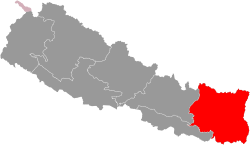Koshi Province (Nepal)
province of Nepal From Wikipedia, the free encyclopedia
province of Nepal From Wikipedia, the free encyclopedia
Koshi Province (Nepali: कोशी प्रदेश),is one of the seven federal provinces of Nepal. It was established in 2015 by the current constitution of Nepal. It was originally called Province No. 1. On March 1, 2023, it was renamed after the Kosi River. The capital city is Biratnagar.[5]
Koshi Province
कोशी प्रदेश/ཤར་པ་ཀླུང | |
|---|---|
|
| |
 Location of Eastern part of Nepal | |
Koshi Pradesh | |
| Coordinates (Biratnagar): 26°27′15″N 87°16′47″E | |
| Country | |
| Formation | 20 September 2015 |
| Named as Koshi Pradesh | 1 March 2023 |
| Named for | Koshi River |
| Capital | Biratnagar |
| Largest city | Biratnagar |
| Districts | 14 |
| Government | |
| • Type | Self-governing Province |
| • Body | Government of Koshi Province |
| • Governor | Parshuram Khapung |
| • Chief Minister | Hikmat Kumar Karki |
| • High Court | Biratnagar High Court |
| • Koshi Provincial Assembly | Unicameral (93 seats) |
| • Parliamentary constituency | 28 |
| Area | |
| • Total | 25,905 km2 (10,002 sq mi) |
| • Rank | 2nd |
| Highest elevation | 8,848 m (29,029 ft) |
| Lowest elevation (Kechana Kawal) | 60 m (200 ft) |
| Population | |
| • Total | 4,961,412 |
| • Rank | 4th |
| • Density | 192/km2 (500/sq mi) |
| • Rank | 4th |
| • Households | 1,191,556 |
| Demonym(s) | Purbeli, Kosheli, Koshyali |
| Demographics | |
| • Religions |
|
| • Ethnic groups | |
| • Sex ratio | 91.48 ♂ /100 ♀ (2011) |
| Development Parameters | |
| • GDP per capita | US$1267 (3rd) |
| • Poverty rate | 0.127[3] |
| • Literacy | 79.7% |
| • Life Expectancy | 69 |
| • HDI | 0.553 |
| Time zone | UTC+5:45 (NST) |
| Geocode | NP-ON |
| ISO 3166 code | NP-P1 |
| Vehicle registration | PROVINCE 1 AB XXXX |
| Official language | Nepali Limbu[4] |
| Other Official language(s) | Bantawa |
| GDP (Nominal) | US$9 Billion (2nd) |
| Website | koshi |
The province is bordered by the Tibet of China to the north, the Indian states of Sikkim and West Bengal to the east, and Bihar to the south, and Bagmati Province and Madhesh Province to the west.[6][7][8] According to the 2021 Nepal census, there are around 5 million people in the province, with a population density of 190 per square kilometre.[9] As per the 2011 Nepal census the province had around 4.5 million people.[10]

Seamless Wikipedia browsing. On steroids.
Every time you click a link to Wikipedia, Wiktionary or Wikiquote in your browser's search results, it will show the modern Wikiwand interface.
Wikiwand extension is a five stars, simple, with minimum permission required to keep your browsing private, safe and transparent.